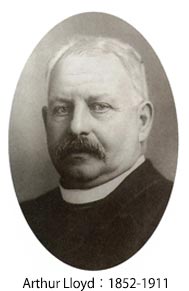アーサー・ロイド について / About Arthur Lloyd

英国人アーサー・ロイドは、英国教会系ミッションSPG(Society for the Propagation of the Gospel. 福音宣教協会)宣教師として1884(明治17)年に来日、10年後の1894(明治27)年からは米国聖公会内外伝道協会(Domestic and Foreign Missionary Society of the Protestant Episcopal Church in the USA)宣教師として1903(明治36)年までの9年間を伝道事業に従事した。
ケンブリッジ大学を優秀な成績で卒業したロイドは、学士、文学修士を取得、15か国語に通じていたといわれ、来日わずか7か月目には早くも日本語で説教をおこなっている。福澤諭吉から慶應義塾の教員のなかで唯一真の学者と当初から認められていたロイドは、慶應義塾で11年にわたり(1885-1890 / 1893-1898 / 1904)教鞭をとった。
さらに、米国聖公会在日ミッション統括者ジョン・マキムに請われて、同派経営の立教学院で5年半(1897.12 - 1903.4)にわたり学院総理を務めた。この間ロイドは、政府認可校において宗教教育を禁じる1899(明治32)年の文部省訓令12号問題に対し、間接的であれ学内で一定のキリスト教教育が可能であれば訓令を順守するという方針で乗り切った。その結果認可校として存続した立教は、上級学校への進学資格や徴兵猶予の特典を維持することが出来た。それと同時に、ロイドは立教における一般教育を強化する教育方針をとり、立教中学校を、訓令発布1年後の高等学校入学試験で受験者(11人)全員が合格した唯一の学校に成長させた。受験生の半分以上が合格した学校はほかになく、これは全国で最上位の成績であった。
こうして当代日本における最大のミッション・スクールとなった立教中学校は、その後の専門学校令による立教学院立教大学設立(1907年)への道を切り開く、大きな要因ともなったのである。
ロイドは慶應、立教のほかに、海軍医学校、海軍兵学校(Naval Academy)、東京専門学校(現・早稲田大学)、東京高等商学校(現・一橋大学)、東京帝国大学(現・東京大学)でもラフカディオ・ハーン後任の英文学教授として教壇に立っている。
ロイドは、尾崎紅葉の『金色夜叉』、徳富蘆花の『自然と人生』などの英訳書や一連の仏教研究書を刊行しており、第二次世界大戦後の1956年においてもロイドの仏教研究所は必読書とされていた。日本アジア協会発行『紀要』(Transactions of the Asiatic Society of Japan)への諸論稿や、日本関連の諸著も多数公刊した学者として知られた人物でもあった。
1911年10月27日に永眠したロイドの葬儀には、教育界や宗教界から総勢300余人が参列して哀悼し、ロイドが異国日本で広く認知されたことが示された。
(立教大学学院史資料センター)
Arthur Lloyd, who is British, came to Japan in 1884 as an Anglican missionary for the Society for the Propagation of the Gospel (SPG). Ten years later, in 1894, he became a missionary for the Domestic and Foreign Missionary Society of the Protestant Episcopal Church in the USA, and engaged in missionary work for nine years until 1903.
Lloyd graduated with excellent results from the University of Cambridge, holding a bachelor’s degree and a master’s degree. He was said to speak fifteen languages, and was preaching in Japanese only seven months after arriving in Japan. Recognized by Yukichi Fukuzawa from the beginning as a truly unique scholar among the teaching staff of Keio Gijuku (Keio University), Lloyd taught there for 11 years (1885-1890, 1893-1898, and 1904).
On the invitation of John McKim, mission overseer of the Protestant Episcopal Church in Japan, Lloyd served for five and a half years (December 1897-April 1903) as president of Rikkyo Gakuin, which was of the same denomination. During that period, Lloyd overcame the problem of the Ministry of Education’s Directive No. 12 in 1899, which banned religious education at government-accredited schools, by his policy of observing the directive so long as Christianity could be indirectly taught to some extent on campus. As a result, Rikkyo maintained its accreditation and continued to be able to grant students access to higher education and exempt them from military conscription. At the same time, Lloyd established an educational policy of strengthening Rikkyo’s general education, resulting in St. Paul’s Middle School becoming the only school where all students (11 students) taking the high school entrance examination passed a year after proclamation of the directive. This was the best performance in the whole country, with no other school getting more than half of its examinees through the examination.
St. Paul’s Middle School went on to become the largest mission school in Japan today, which was a major factor in later opening up the way for the foundation of St. Paul's College, Tokyo (1907) under the government’s Acts of Colleges.
In addition to his work at Keio and Rikkyo, Lloyd also taught at the Imperial Naval Medical College, the Imperial Japanese Naval Academy, Tokyo Senmon Gakko (currently Waseda University) and the Tokyo Higher Commercial School (currently Hitotsubashi University), and succeeded Lafcadio Hearn as professor of English literature at Tokyo Imperial University (currently the University of Tokyo).
Lloyd published English translations of Japanese literatures, such as “Gold Demon” (“Konjiki Yasha”) by Koyo Ozaki and “Nature and Man” (“Shizen to Jinsei”) by Roka Tokutomi, as well as a series of Buddhist studies. His Buddhist research papers were considered required reading as late as 1956, after World War II. He was also famous as a scholar for his articles in the “Transactions of the Asiatic Society of Japan” and countless other Japan-related publications.
Lloyd passed away on October 27, 1911, and his funeral was attended by more than 300 mourners from educational and religious circles, which was evidence of how widely recognized he was in this foreign country, Japan.
(The Rikkyo Archives)
